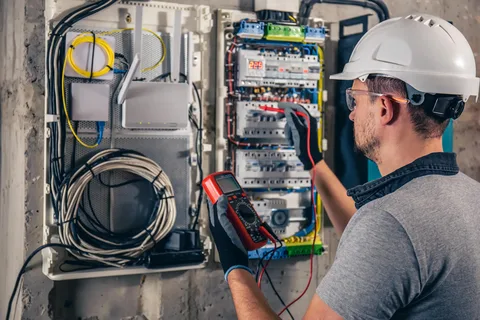
electrician
Now and then, your lights flicker or an outlet dies for no reason. Suddenly, everything feels off. But most of the time, it leads back to your breaker panel. And if you’re like most people, you’re probably wondering—what now? You’re not an electrician, after all.
Thankfully, you don’t have to figure it out alone. An electrician San Diego can troubleshoot breaker problems step by step. They don’t guess—they diagnose. In fact, they follow a process that’s safe, smart, and built for speed.
You’ll also discover what symptoms mean real danger and when to step back and call a pro. Let’s break it down clearly, simply, and in plain English.
An Electrician Understands Why Circuit Breakers Trip In The First Place
To begin with, a breaker trips when it senses something is wrong. After all, its job is to stop electricity when danger is near. Usually, this happens because of:
- Overloads
- Short circuits
- Ground faults
- Faulty appliances
- Worn-out wiring
Because of these possible issues, an electrician always starts here. First, they figure out what triggered the breaker. Then, they check what was running when it happened. If your toaster, hairdryer, and heater were all on, that’s a clue.
Moreover, they look at the panel itself. A hot or noisy breaker is always a red flag.
Consequently, if your breaker keeps tripping even after a reset, that’s your sign to call for help.
Visual Inspection Always Comes First
Once the problem is suspected, the next move is visual inspection before testing anything, a pro looks.
During this step, they check:
- Burn marks
- Scorched insulation
- Loose screws
- Melted plastic
- Unusual smells
Because safety matters, electricians do not guess. Instead, they observe first. For example, a blackened wire instantly points to overheating.
Quick Tip: Please don’t open your panel if unsure how. Even touching the wrong spot can result in injury.
The electrician confirms whether the wires and breaker ratings are compatible as soon as the visual check is complete. If not, they replace or repair as needed before moving on.
Testing the Circuit Load
Sometimes, your circuit breaker trips not because of damage, but because it’s overwhelmed. That’s why testing the load is critical.
For instance, a kitchen with too many gadgets can overload the system quickly. You’ll notice things like:
- Lights dimming when you plug things in
- Sudden shutdowns
- Wall plates that feel hot
- Buzzing from switches
To avoid this, the electrical installation service San Diego tests how much power flows through each circuit. Then, they compare it to the breaker’s rating for handling.
Fact: A 20-amp breaker can only handle around 2,400 watts safely.
If your load is too high, they’ll recommend a few changes:
- Move heavy appliances to other circuits
- Upgrade the wiring
- Replace the breaker with the right rating
- Add a dedicated circuit for demanding devices
- Rearrange furniture to reduce plug overload
Doing this prevents frequent interruptions and protects your devices from damage.
Checking for Short Circuits
Short circuits are dangerous—and that’s no exaggeration. When a hot wire touches neutral or ground, the breaker instantly trips.
So, how do electricians find it? First, they unplug everything. Then, they test wires with a multimeter to check for continuity.
Whenever the meter beeps unexpectedly, they know something’s wrong.
From that point on, they trace the path—outlets, switches, and wires—until they locate the short. Often, signs like melted plastic or exposed copper make things obvious.
Danger: Never poke into an outlet with tools if unsure what you are doing. Always turn off the main breaker.
Once the issue is found, the electrician replaces damaged wires and tests again before declaring it safe.
Inspecting for Ground Faults
Ground faults, though common, are sneaky. They usually happen in damp areas—kitchens, basements, and bathrooms. That’s why GFCIs exist.
In this step, electricians test outlets and breakers. First, they use a tester to simulate a fault. Then, they check whether the GFCI reacts correctly. If it doesn’t, they dig deeper. Moisture may have damaged the wiring inside the wall. Alternatively, an appliance may be leaking current.
Since ground faults are hard to see, tools make all the difference. Moreover, hiring an electrician San Diego has everything needed to spot even small risks.
Once identified, they fix or replace outlets, wires, or appliances. As a result, your circuits stay safe, and your breaker stops flipping unnecessarily.
Using Diagnostic Tools for Accuracy
Even the best electrician can’t solve issues without tools. That’s why diagnostic gear matters so much.
Let’s look at what they carry:
| Tool | What It Does |
|---|---|
| Multimeter | Tests for voltage and resistance |
| Clamp meter | Measure current load |
| Voltage tester | Checks if a wire is live |
| Circuit tracer | Maps out what each breaker controls |
| Screwdrivers | Tightens all the terminals |
With these tools, there’s no guessing. Instead, electricians can pinpoint which breaker is faulty or which wire has failed—fast.
Therefore, hiring someone who comes prepared saves time, money, and stress.
Fixing Loose or Damaged Wiring
Loose wiring is a quiet troublemaker. It may not trip the breaker immediately, but it will slowly damage your system.
Here’s what you might notice:
- A certain outlet trips often
- Lights flicker in one room only
- Slight burning smells from outlets
While these symptoms may seem minor, they point to bigger issues.
To fix it, electricians unscrew outlet covers and carefully inspect wires. Then, they reconnect them firmly or replace them if damaged.
Sometimes, wires were never tightened properly to begin with. Other times, old insulation wears out.
Warning: Avoid using extension cords or adapters to “fix” these issues. It only makes things worse.
Once repaired, everything gets tested again. Only then do they confirm it’s safe.
What You Can Expect From An Electrical Installation Service
Now that you understand the process, let’s walk through a real visit.
- First, they’ll ask you what’s happening and when the problem started.
• Next, they’ll open the panel and visually inspect it.
• Then, they’ll test each breaker and outlet, using meters and tracers.
• After that, they’ll identify the fault—whether it’s a short, overload, or loose wire.
• Finally, they’ll fix the issue and test everything again.
This routine helps the electrical installation service diagnose efficiently. As a result, they ensure your home stays safe and fully powered.
When To Call A Contractor Immediately
At some point, DIY isn’t enough.
If you notice any of the following, search for an “lighting contractor near me,” right away:
- The breaker trips again after reset
- You smell burning near the panel
- Breakers feel hot or buzz
- The panel sparks
- Nothing is plugged in, but it still trips
Any of these signs could mean danger.
At that point, don’t wait. A licensed electrical installation service will get to the root before damage worsens. Trust their experience—they deal with this daily, so you don’t have to.
Conclusion
So, what’s the real answer to “How does an electrician troubleshoot circuit breaker issues?”
They follow a clear path—start with inspection, test wires and loads, use the right tools, and fix problems safely. They know what to do and when, whether it’s a short, overload, or loose wire.
Hiring an expert team at D & N Electric means you get safe power, fewer interruptions, and peace of mind. No more flickering lights. No more sudden outages. Just reliable electricity, the way it should be.





